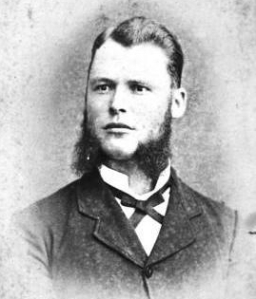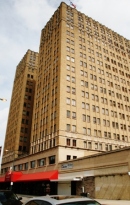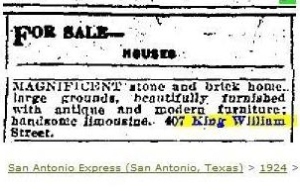If you have been following Villa Finale’s events and programs, then you are probably aware that we will be hosting our second seance in 2018. But this year it’s more than just one night, it’s an entire weekend for those who are interested in spiritualism and the mystery behind historic homes. Our “spiritual weekend” – Friday, October 12 and Saturday, October 13 – will feature two seances and a pendulum workshop at three different historic homes in the King William neighborhood, each with its own stories of loss and sadness.

“Hello From the Other Side” seance at Villa Finale, 2017.
The weekend begins on Friday, October 12th at Villa Finale with night one of “Hello From the Other Side: 75 Years of Spiritualism and a Live Seance.” Seance-goers will be treated to light refreshments and bar drinks themed to the evening’s occasion before being led into the house for the main event being presented by the duo of Austin Seance. Built in 1876 and remodeled at least four different times, Villa Finale has seen its share of people come and go throughout its 142-year history. Those of us who were in the house during last year’s seance “heard” footsteps in the rooms directly above us and on the main staircase. Could these sounds have been figments of our imagination? Or maybe it was the Polk family who lost the house through foreclosure in 1895 and have never really left? Could it have been Billy Keilman who owned the home and ran a brothel and speakeasy here in the mid 1920s, and was murdered off-site during his tenure? Perhaps it was one of Keilman’s disgruntled customers? We may never find out!

Otto Meusebach, ca. 1890s.
On Saturday, October 13 at 2:00pm, the weekend’s activities continue with “Pendulums: A Workshop for the Mind and Spirit” being held at Villa Finale’s Meusebach House, located across the street at 414 King William Street. Participants will learn about the history of pendulums and how to make and use them. Pendulums are simple devices that have long been used to communicate with spirits, and folks will get a chance to do just that at this historic house. Built in 1886 by Smith and Josie Ellis, the couple sold the house to Otto Carl and Martha Meusebach in 1889. Otto and his brother, Max who lived in the house briefly in the 1890s, were sons of German pioneer John O. Meusebach, founder of Fredericksburg. Both Otto and Max were known for participating in raucous saloon brawls throughout town. On November 4, 1900, the Meusebach’s fourteen-year-old daughter, Anita, died in the house after days of being ill with peritonitis. As was the custom at the time, Anita’s funeral was held in the Meusebach home. Does the spirit of Anita remain in her family’s home? Or do the rough and tough souls of Otto and Max refuse to rest? Participants at the pendulum workshop may find out!

Johanna Steves, undated. Courtesy of the San Antonio Conservation Society.
The last of the weekend’s activities happens later on Saturday evening with seance number two being held at the Edward Steves Homestead located one block from Villa Finale and the Meusebach house. Edward and Johanna Steves built their home in 1876 following the success of their lumber company. Just like Villa Finale and the Meusebach house, the Steves home has also seen its share of sorrow. Following Edward’s death in 1890, family members talk about Johanna sleeping in the hallway outside of the master bedroom during her period of mourning. But Johanna was a tough German woman who, despite being under 5-feet tall, was master of her home and lived there for forty years following her husband’s death. Although she baked cookies for the neighborhood kids and allowed them to swim in her pool, Johanna expected her pool cleared for her own private swim as soon as she rang a bell from her back porch.
Johanna died in 1930 within two weeks of her beloved son Ernest’s death. Ernest, who was the youngest, had been admitted to the hospital to get his appendix removed but, as was not too uncommon at the time, didn’t survive the procedure. Newspapers speculated Johanna died of a “broken heart” but, certainly, being 90 years old also didn’t make coping with the sorrow any easier. Like Anita Meusebach, Johanna’s casket lay in state in her home, right in front of the formal parlor’s bay window. During night two of the seance, will Johanna announce her private swim by ringing her bell? Will laughter from neighborhood children of bygone days be heard again? Join us and find out!
You can purchase each of the three events of Villa Finale’s “spiritual weekend” separately: “Hello From the Other Side” seance night one at Villa Finale ($55.00 per person), “Pendulums: A Workshop for the Mind and Spirit” at the Meusebach House ($10.00 per person), or the “Hello From the Other Side” seance night two at the Steves Homestead ($55.00 per person). If choosing just one is difficult, you can participate in all three with the “spiritual weekend bundle”: $100.00 for a chance to see “who” says “hello” from the spirit world in each of these fascinating historic homes! Come experience it for yourself.
Seance nights include light refreshments and alcoholic beverages. Seances are for audiences 18 and older only. Space is limited for all three. Click on the links below to purchase admissions or call (210) 223-9800 during business hours for tickets or more information.
Seance nights one and two and “spiritual bundle”
Workshop only – “Pendulums: A Workshop for the Mind and Spirit”








































